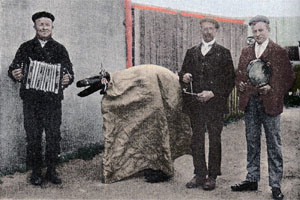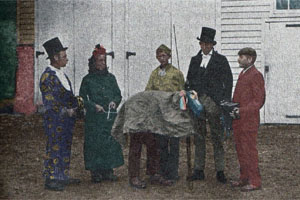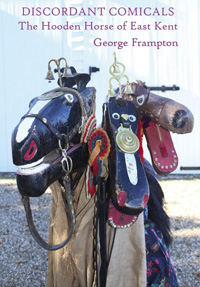Book Review: 'Discordant Comicals: The Hooden Horse of East Kent'
by George Frampton.
St Nicholas-at-Wade: Ozaru Books, 2018, 235pp.
ISBN 978-0-9931587-7-3, £24.99
To quote from the back cover of this book:
"Hoodening is an ancient calendar custom unique to East Kent, involving a wooden horse's head on a pole, carried by a man concealed by a sack."
The introduction, after quoting an example account of the tradition, continues:
"Quite simply, the hooden horse was an effigy skilfully carved from wood, with a jaw usually made to open and shut by operating a string from inside the cloth, used by a team of farm workers (the hoodeners) in an effort to elicit alms."
We may add that the hoodeners took their horse around Christmas time round the farms and big houses in the villages and towns of their locality. In addition to their horseplay, they often sang, but they might also do other things such as handbell ringing, and there were some hoodeners who did not have a horse.
One wonders how much we would know about Hoodening if the Canterbury solicitor Percy Maylam had not taken an interest in the custom and published his seminal book "The Hooden Horse" in 1909, because the original tradition seems to have become largely dormant by the 1920s. Maylam's book assisted the revival of the custom by folk enthusiasts and others from 1939 onwards, with several groups continuing today.

Hoodeners at Walmer pose for Percy Maylam A few books based on Maylam's work have been published in the past 40 years, including an earlier edition of this book published in 2006, and of course there are dedicated websites. This new volume extends the coverage of the previous edition, and has been attractively published in hardback with numerous colour illustrations. Oddly, although most of the photographs were originally black and white pictures, they have all been colourised. It is moot point whether or not this is a good thing from the academic point of view. Please note that the images reproduced in this review are copyright © Ozaru Books, 2018.
The strength of this book is as a comprehensive sourcebook. Frampton gathers together all the available historical records of hoodening, quoting them in full within a readable linking narrative. These are supplemented by an appendix of biographical information about those participants who are named in the historical records, culled from family history resources, which provides a clear insight into their social backgrounds. They were primarily farm workers, except in Deal, where the Hoodeners were drawn from a variety of trades. Another appendix also reproduces the words and music of the songs that the pre-war Hoodeners sang, although these are drawn from the original sources, mostly music hall, rather than collected from the tradition. Yet another appendix brings together photographs and descriptions of all the surviving horses.
Most county sourcebooks for folk plays or other customs, tend to arrange their data alphabetically by village. This book, however, has a more narrative approach, splitting the information up into five districts in east Kent, plus a chapter on modern revivals. This makes for a more connected read than the alphabetical village lists, where the information can seem disjointed. The corollary to this is that people wishing to find information from a particular location are reliant on the indexes, and here there is a bit of confusion. There is a Cawte-like gazetteer that tabulates all the places where traditional sides performed, but this is not an index and they are not all included in the complementary Index to Teams, although they may be listed in the Index to Locations. Conversely, many places appear in both indexes, and I cannot help but feel that a combined team and location index would have been more helpful.

Hoodeners at Sarre, 1905A lot of admirable spadework and academic endeavour has gone into preparing this volume, but it is primarily a sourcebook for performers and local historians rather than for folklore academics. Having said that, the chapter on players and performance does bring together the threads of the other chapters to discuss various aspects of Hoodening both in terms of the nature of the performance and the social history of the performers and their audience. Topics include: parodying farm work, the centrality of the 'horse', the Christmas carol and musical aspects of the entertainment, costumes, venues and itineraries, and the factors affecting continuity.
The chapter on origins enumerates a mishmash of customs featuring a 'horse', but not really reaching a conclusion or hypothesis. The impression that emerges from this is that a 'horse' or some other 'animal' is a common motif or trope that could feature in any custom, and one that could be independently reinvented multiple times in different places - even in Kent.
There is no bibliography as such. Copious references are given throughout in footnotes, although some citations lack full references, and their inclusion in the indexes of 'Names' and 'Publications' is inconsistent if not sometimes downright peculiar. To take a random example, 'John Marbrook's Music Book' is indexed under 'J' in the Index to Publications, and not indexed at all in the Index of Names. Even Percy Maylam's key book 'The Hooden Horse' is indexed under 'T'.
Two of the appendices are based on articles that have already been published elsewhere. "Twenty-first century Mumming tradition", originally published in Living Tradition discusses how and why modern mumming sides compose new plays. This is more relevant to Master Mummers' core subject, but extends to the St Nicholas-at-Wade Hoodeners, as they have made topical dialogue a key part their performance. "Goodening", previously published in Bygone Kent, summarises the ostensibly unrelated custom (but with a similar sounding name) of begging on St Thomas's Day.
Peter Millington
|


